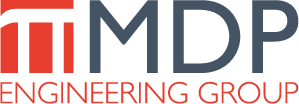Insights: Designing for a Pandemic
With the rise of the current COVID-19 pandemic comes the rise of questions posed to our industry about how it will approach design of the built environment moving forward. Occupant safety has always been a priority, however the standards for what is safe have changed with the progression of the recent virus – there’s a new normal. Now that amenities like elevators, conference rooms, kitchens, and lobbies pose an unseen threat to the wellbeing of the user, Engineers and Architects must consider new design approaches for disease control and occupant safety. Will we start to see hotels, retail spaces, and offices implementing design strategies used in hospitals? The truth is that we don’t know, but what we do know is that design is being reconsidered and we at MDP Engineering Group (MDP) are doing our best to stay at the forefront of that research.
A Position Report released by AHRAE in April 2020 states that “with infectious diseases transmitted through aerosols (small airborne particles), HVAC systems can have a major effect on the transmission from the primary host to secondary hosts. Decreasing exposure of secondary hosts is an important step in curtailing the spread of infectious diseases.“ MDP has been talking with clients and hosting internal conversations regarding ways in which mechanical design can help prevent the spread of COVID-19 and other similar pathogens (bacteria or viruses that cause disease) in different building types. The good news is that MDP has been implementing many of the suggested design changes for several years, thereby exceeding code requirements and utilizing best practices to design healthier buildings.
Prevention
From a mechanical design perspective, keeping the pathogen out of the building in the first place is the best prevention. But with office buildings, hotels, and restaurants reopening and new building construction continuing to move forward, a pathogen-free environment is unlikely. Pathogens are often spread via droplets and aerosols in the air generated by coughing, sneezing, breathing, and talking. Therefore, suggesting that occupants wear masks to keep droplets and aerosols from spreading from person to person is another important means of prevention. Once in the air, many of these droplets get weighed down by gravity and land on surfaces, which means that sanitizing surfaces is still a critical step to preventing the spread of disease in a building. Many buildings are implementing touch-less systems including faucets and doors wherever possible. However, a number of the droplets may evaporate or be desiccated, making them light enough and small enough to be carried through the air via airflow patterns in the space, which means that HVAC systems can have a significant impact on preventing the spread of pathogens. Of particular interest are smaller particles or aerosols (which can carry COVID-19) that desiccate to become “droplet nuclei”. Due to their smaller size, they can remain airborne and infectious for longer periods of time and are small enough to get swept up into HVAC systems and deposited elsewhere in a building. A key to traditional mechanical design is to achieve the optimal mix of airflow (outside air and filtered recirculated air) to circulate throughout a building. This concept of circulation is not necessarily ideal when attempting to isolate the spread of pathogens making dilution and pressurization extremely important.
Dilution
Dilution is a result of the amount of outside air being supplied into a building to replace the existing air. Typically, the more outside air you bring in the healthier the building environment. Bob Finnerty, Building Engineer for Independence Plaza in Downtown Denver said that when COVID-19 hit and occupants transitioned to remote status, he ran the mechanical system in the mostly unoccupied building at 100% outside air for a 24 hours per day for 7 days to fully flush out the air in the building. As tenants are returning to Independence Plaza, the mechanical system is turned on 100% outside air 2 hours prior to occupants arriving in the building to flush out the existing air and any pathogens that may be lingering from the previous day. In addition, attention must be given to the controls sequence that uses an enthalpy based outside air economizer that senses humidity as well as temperature in lieu of a dry bulb type economizer which sense temperature only, as the latter allows for more hours of operation in a dry climate like Colorado. It is also important to disable the Demand Control Ventilation (DCV) to manually control the amount of outside air being pulled into the building.
In ground-up multifamily and hospitality projects, corridors and shared spaces are usually where dilution is focused as those areas are likely to develop more pathogens. According to Eric Ellingboe, P.E., MDP Engineering Group will typically design the mechanical system for such projects to pump in additional outside air, above what is required by code because we believe it keeps the building fresh and occupants healthier. The additional outside air also results in keeping buildings, and especially densely occupied spaces, positively pressurized in relation to their surroundings as recommended by ASHRAE. Depending on the building type, increasing dilution can be a design change or more of an operational change, however it is a simple change that can make a big difference to the quality of the air and the health of those breathing it.
Filtration
Another element to dilution is the rating of the air filter used to filter the outside air as it enters the building as well as any recirculating air. Filters are rated on a MERV (Minimum Efficiency Reporting Value) scale from 1-16 with 16 capturing the most and the smallest particles, often used in hospital clean rooms. Beyond MERV are HEPA filters which catch up to 99.97% of dust, pollen, mold, bacteria, and any airborne particles with a size of 0.3 microns. (Environmental Protection Agency, “What is a MERV Rating”, Indoor Air Quality) Eric Ellingboe, P.E. explains that MDP Engineering Group will typically design mechanical systems that specify filters with MERV ratings of 13. This rating is achieved by utilizing a MERV filter with a rating of 8 as the primary filter followed by a MERV filter with a rating of 14 to achieve a net rating of 13. This is a quality filter design that will catch 84% of particles that are approximately 0.3 – 1.0 microns and up to 90% of particles that are 1.0 – 3.0. MDP often designs buildings for LEED certification which requires a filter rating of MERV 13. It is likely that there will be greater demand for higher rated filters, possibly even HEPA filters moving forward as owners and occupants grow more concerned with the quality of their air across all project types. For example, Independence Plaza upgraded their filters to MERV 11 prior to the outbreak of COVID and plans to replace them with MERV 13 filters when replacement time comes.
John Runnels, P.E. explains there is a caveat to upgrading air filters in an existing building being that it is critically important to confirm that the existing mechanical fans have the capacity to move the air through the denser filters. The higher rated filters are often harder on the mechanical system because it encounters more resistance when pulling the air through the filter. Higher rated filters also need to be changed more regularly because they are catching more particles and get dirty quicker. In regards to ground up projects, a MERV 13 filter is the happy medium between filtering out the majority of contaminants while remaining energy efficient. Although it would be possible to design every new building with a MERV 16 or HEPA filter, those filters cause more stress to the mechanical systems and require much higher levels of energy to use, thereby rendering them more inefficient and harder on the environment.
Ultraviolet Germicidal Irradiation
Two additional design options that MDP is implementing for purifying air in commercial buildings is the use of Ultraviolet Germicidal Irradiation (UVGI) systems and Needlepoint Bi-polar Air Ionization (NBPI). UVGI is not new technology and has been around for approximately 30 years. However, it has gained ground in HVAC design in the last couple of years because of its proven success in killing pathogens in other uses. Although SARS-CoV-2 (the virus that causes COVID-19) has not been tested in depth for its susceptibility to UV-C light, similar viruses have been tested extensively and are shown to be killed when they come in contact with UV-C. UVGI systems are either positioned adjacent to a cooling coil and drain pan area in the duct system to zap the air and prevent the replication of viruses and bacteria or they are installed in an occupied space to irradiate the air in the upper region of the space.
Needlepoint Bi-polar Ionization
Most recently, MDP is using Needlepoint Bi-polar Ionization (NBPI) in several of its Senior Living projects. In response to COVID-19, Owners and Architects of Senior Living communities, the population that’s been hit the hardest by the virus, have requested this type of system which has been historically effective in preventing other types of virus spread. By releasing ions into the air, the system works in several ways to kill pathogens, trap particles, and remove odors. Ions bind to pathogens in the airways and robs them of the hydrogen they need to survive thereby rendering them ineffective. The ions also have the ability to bind to particles like droplets, aerosols, dust, skin, etc. and make them large enough to be captured by the air filter. In addition, NBPI works to remove odors by breaking them down into oxygen, carbon, and water vapor.
Conclusion
All of us in the design community are charting new territory and MDP Engineering Group is working to stay apprised of any new technology that may help us design safer spaces to combat COVID-19 and future viruses. We are closely following the research and design suggestions presented by ASHRAE and have found that we have been implementing many of them long before the start of COVID-19 and will continue to do so even more diligently now. We want to support our clients in building new projects that they feel are safe for their occupants and we want to help our clients with existing buildings better understand their options for making their buildings safer and healthier. We are all in this together, and we will continue to find ways to design a built environment that supports healthy, thriving communities.




